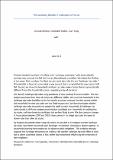| dc.contributor.author | Simester, Duncan | |
| dc.contributor.author | Tucker, Catherine Elizabeth | |
| dc.contributor.author | Yang, Clair | |
| dc.date.accessioned | 2021-03-15T14:11:27Z | |
| dc.date.available | 2021-03-15T14:11:27Z | |
| dc.date.issued | 2019-09 | |
| dc.date.submitted | 2019-06 | |
| dc.identifier.issn | 0022-2437 | |
| dc.identifier.issn | 1547-7193 | |
| dc.identifier.uri | https://hdl.handle.net/1721.1/130136 | |
| dc.description.abstract | Previous research has shown that there exist “harbinger customers” who systematically purchase new products that fail (and are discontinued by retailers). This article extends this result in two ways. First, the findings document the existence of “harbinger zip codes.” If households in these zip codes adopt a new product, this is a signal that the new product will fail. Second, a series of comparisons reveal that households in harbinger zip codes make other decisions that differ from other households. The first comparison identifies harbinger zip codes using purchases from one retailer and then evaluates purchases at a different retailer. Households in harbinger zip codes purchase products from the second retailer that other households are less likely to purchase. The analysis next compares donations to congressional election candidates; households in harbinger zip codes donate to different candidates than households in neighboring zip codes, and they donate to candidates who are less likely to win. House prices in harbinger zip codes also increase at slower rates than in neighboring zip codes. Investigation of households that change zip codes indicates that the harbinger zip code effect is more due to where customers choose to live, rather than households influencing their neighbors’ tendencies. | en_US |
| dc.language.iso | en | |
| dc.publisher | SAGE Publications | en_US |
| dc.relation.isversionof | http://dx.doi.org/10.1177/0022243719867935 | en_US |
| dc.rights | Creative Commons Attribution-Noncommercial-Share Alike | en_US |
| dc.rights.uri | http://creativecommons.org/licenses/by-nc-sa/4.0/ | en_US |
| dc.source | Prof. Tucker | en_US |
| dc.title | The Surprising Breadth of Harbingers of Failure | en_US |
| dc.type | Article | en_US |
| dc.identifier.citation | Simester, Duncan I. et al. "The Surprising Breadth of Harbingers of Failure." Journal of Marketing Research 56, 6 (September 2019): 1034-1049. © 2019 American Marketing Association | en_US |
| dc.contributor.department | Sloan School of Management | en_US |
| dc.relation.journal | Journal of Marketing Research | en_US |
| dc.eprint.version | Original manuscript | en_US |
| dc.type.uri | http://purl.org/eprint/type/JournalArticle | en_US |
| eprint.status | http://purl.org/eprint/status/NonPeerReviewed | en_US |
| dc.date.updated | 2021-03-08T18:00:40Z | |
| dspace.orderedauthors | Simester, DI; Tucker, CE; Yang, C | en_US |
| dspace.date.submission | 2021-03-08T18:02:22Z | |
| mit.journal.volume | 56 | en_US |
| mit.journal.issue | 6 | en_US |
| mit.license | OPEN_ACCESS_POLICY | |
| mit.metadata.status | Complete | |

